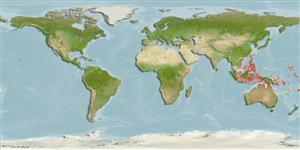Teleostei (teleosts) >
Anguilliformes (Eels and morays) >
Ophichthidae (Snake eels) > Ophichthinae
Etymology: Yirrkala: Named for its type locality Yirrkala, Caledon Bay, Gulf of Carpentaria, Queensland, Australia.
More on author: Günther.
Environment: milieu / climate zone / depth range / distribution range
Ecology
Marine; demersal; depth range 200 - 400 m (Ref. 127429). Tropical
Western Central Pacific.
Size / Weight / Age
Maturity: Lm ? range ? - ? cm
Max length : 51.2 cm TL male/unsexed; (Ref. 127429)
A benthic and burrowing species that lives in coral rubble bottom (ecological information needed) (Ref. 127429).
Life cycle and mating behavior
Maturity | Reproduction | Spawning | Eggs | Fecundity | Larvae
Smith, D.G. and J.E. McCosker, 1997. Ophichthidae. Snake eels, worm eels. p. 1662-1669. In K.E. Carpenter and V.H. Niem (eds.) FAO species identification guide for fishery purposes. The living marine resources of the WCP. Vol. 3. Batoid fishes, chimaeras and bony fishes part 1 (Elopidae to Linophrynidae). FAO, Rome. (Ref. 39782)
IUCN Red List Status (Ref. 130435: Version 2024-1)
Threat to humans
Harmless
Human uses
Tools
Special reports
Download XML
Internet sources
Estimates based on models
Preferred temperature (Ref.
123201): 26.1 - 29.3, mean 28.7 °C (based on 1299 cells).
Phylogenetic diversity index (Ref.
82804): PD
50 = 0.5000 [Uniqueness, from 0.5 = low to 2.0 = high].
Bayesian length-weight: a=0.00091 (0.00039 - 0.00215), b=2.99 (2.79 - 3.19), in cm total length, based on LWR estimates for this (Sub)family-body shape (Ref.
93245).
Trophic level (Ref.
69278): 3.8 ±0.6 se; based on size and trophs of closest relatives
Resilience (Ref.
120179): Medium, minimum population doubling time 1.4 - 4.4 years (Preliminary K or Fecundity.).
Fishing Vulnerability (Ref.
59153): Moderate vulnerability (40 of 100).
